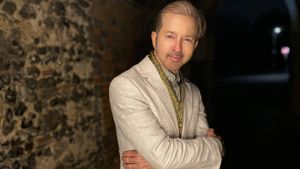At the Los Angeles
Gay and Lesbian Center during the past few
years, the staff has become more and more used to gay
men who test positive for HIV after admitting to a
crystal meth addiction. "If you had asked any of our
counselors, anecdotally, they would have said that 90%
of new HIV cases were linked to meth," says
Quentin O'Brien, the center's director of
health and mental health services.
It's not
quite that high, but still alarming.
In June the
center released startling findings: Nearly one in three gay
and bisexual men who tested positive at the clinic in 2004
admitted to using meth. That rate is nearly three
times greater than the proportion of HIV-positive men
who admitted using the highly addictive drug in 2001.
In addition, more than 10% of all men who have sex with men
tested at the center in 2004 said they had used meth,
almost double the rate from 2001.
"There's evidence we're still on an
upward trend, and it's not abating,"
O'Brien tells The Advocate. "For gay
men it's linked to sexuality. It is so strong
that many people who say that once they have sex on
crystal, there's no going back. We need to let them
know that things that are often appealing have a
consequence."
The Los Angeles
Gay and Lesbian Center's data was released at a
national HIV prevention conference, as was another
unsettling piece of news: The number of Americans now
living with HIV has passed the 1 million mark.
Officials call
that news a mixture of good and bad. On one hand, it means
that a greater number of people are living longer on
anti-HIV drugs that were not around when the virus
ravaged gay men in the 1980s.
"While
treatment advances have been an obvious godsend to those
living with the disease, it presents new challenges
for prevention," Ronald Valdiserri, deputy
director of the Centers for Disease Control and
Prevention's National Center for HIV,
STD, and TB Prevention, told attendees. He renewed a
call for health officials to reach the estimated 25% of
Americans who have contracted HIV but do not know it.
The new estimates
indicate that African-Americans account for 47% of HIV
cases, and gay and bisexual men make up 45% of those living
with the virus that causes AIDS, the CDC believes.
Yet the new
figures also mean that the CDC has failed on a pledge made
in 2001, when the agency set a goal of cutting in half
the 40,000 new HIV infections that have occurred
annually since the 1990s. "It is clear that we
have not achieved that goal. We have not halved the rates of
new infections," Valdiserri told the
conference. "But we do think we are making
progress."
Some health
officials believe that the number of new annual infections
is closer to 60,000. "We're seeing more
infections, that's the bad news. But the good
news is that many of us are living longer," says
Terje Anderson, who was diagnosed with HIV eight years
ago and with AIDS four years ago. He now serves as
executive director of the National Association of People
With AIDS. "It just points out how far we still have
to go in really dealing effectively with this in this
country. Maybe passing the million mark will drive
home that this thing is getting bigger and it's not
going away."


















































































